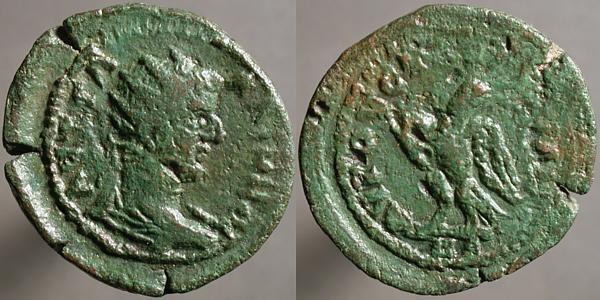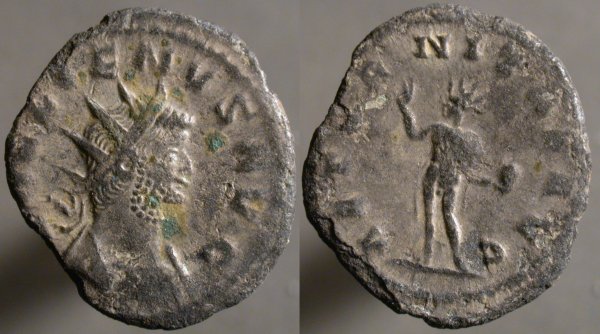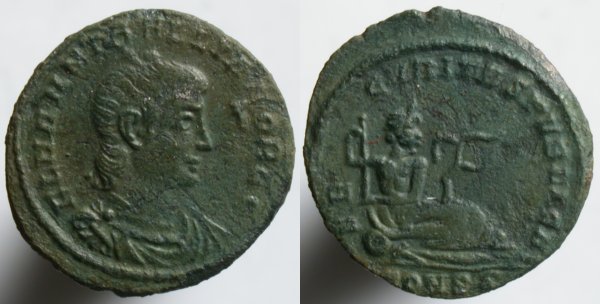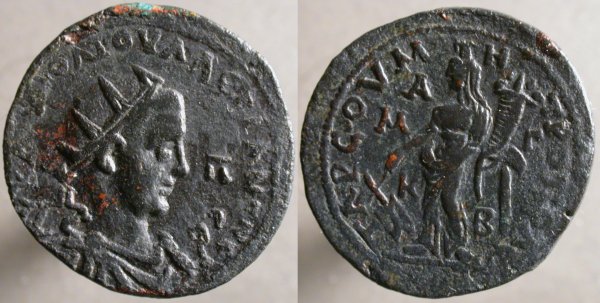Friday, July 21, 2006
Æ27, Augusta Traiana in Thrace, Gallienus, Varbanov (2005) 1400

AVT ΓA_ΛΛIHNOC, Radiate draped bust right | AV[Γ]OVC[THC TPAIANHC], Eagle standing left, head right.
I wasn't able to find this coin in a catalog until I got the second volume of the (English-language) 2005 Varbanov book. While entries in the 2002 Bulgarian-language edition have the Greek names of gods & goddesses, if they appear on a coin, transliterated into Bulgarian, having the coin's description in English is neccessary for those of us who have no Bulgarian when the coin features something other than a diety.
I've just bought a copy of Vol. 2, which covers half of Thrace, like this coin, and I hope Vol. 3, which will cover the rest of Thrace, like Serdica, becomes available soon.
Thursday, July 20, 2006
Billon antoninianus, Gallienus, Rome, Göbl 576w

GALLIENVS AVG, Radiate cuirassed bust right | AETERNITAS AVG, Radiate Sol standing left, raising right hand and holding globe raised in left.
As the link in the title shows, this is, again, like Monday, an upgrade destined to be an intermediate one. My excuse here is that this was part of a multiple-coin lot and that I wanted one of the others, based my bid for the lot on that oher coin and can treat this as though it was free of charge.
Wednesday, July 19, 2006
Æ4, Hannibalianus, Constantinopolis, RIC 147

FL HANNIBALLIANO REGI, Bare-headed draped cuirassed bust right | SECVRITAS PVBLICA, Euphrates reclining right, holding scepter with both hands, reed growing behind him. CONSS in exergue.
Constantine, after bad experience with his son Crispus, had raised his three sons Constantine II, Constantius II, and Constans and his nephew Delmatius to succeed him, perhaps hoping to revive Diocletian's Tetrarchy this time bound more closely by blood rather than marriage.
Another nephew, Flavius Hannibalianus, brother of Delmatius, was named King of Pontus, a client region not then under Roman control with Hannibalianus never visited. Like his brother and many other relatives, Hannibalianus was killed in a purge that followed the death of Constantine in 337.
The birth of the Roman Republic came when the consul L. Junius Brutus exiled the last Roman king, Tarquinius Superbus, before Rome began issuing coins.
During all the time of the Republic and the Empire, no coins honoring anyone as King were issued, except these for Hannibalianus, who was the short-lived king of nothing.
Tuesday, July 18, 2006
Æ35, Tarsus in Cilicia, Valerian, SNG von Aulock 6076

AVT [KAI Π] ΛI OVAΛEP]IANON EV / C C, Radiate draped cuirassed bust right, Π before and behind | TAPCOV M_H_TPOΠOΛEΩN, Tyche standing facing, holding rudder with right hand and cornucopiae with left. A/M/K in left field, Γ / B in right field.
It's not that I've never seen Tyche on a coin of Tarsus but not in the most common “Tyche standing” pose.
Still, I find this an interesting coin, in part because of the size. It's not my only 35mm coin from Tarsus, but it's the thickest and, at 26.6 grams, it's by far the heaviest: you'd need a balance to determine the difference from the weight of an old US silver dollar.
While I don't know what this coin could have bought in ancient Tarsus, very many in a purse would have weighed you down on that side, and swimming would be right out.
Monday, July 17, 2006
Æ antoninianus, Gallienus, Mediolanum, Göbl 1383a

GALLIENVS AVG, Radiate head right | AETERN AVG, Radiate Sol standing facing, weight on his left leg, holding globe right, raising hand left. MT in exergue.
If asked about “upgrades” I'd say that I would only upgrade once: to an example that I won't be able to improve further. Today's coin, an upgrade to this, suggests that's not always accurate: if my exising example is poor enough and the upgrade is inexpensive enough, then I may talk myself into bending my rule.

